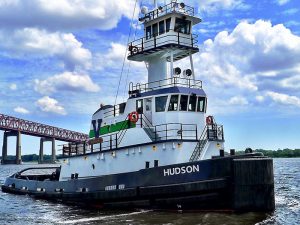
Vane Brothers adds to its fleet
MAY 13, 2016 — Baltimore, MD, headquartered Vane Brothers has added two more vessels its growing fleet: the 4,200 horsepower tugboat Hudson and the 55,000 barrel barge Double Skin 601. The Hudson

MAY 13, 2016 — Baltimore, MD, headquartered Vane Brothers has added two more vessels its growing fleet: the 4,200 horsepower tugboat Hudson and the 55,000 barrel barge Double Skin 601. The Hudson
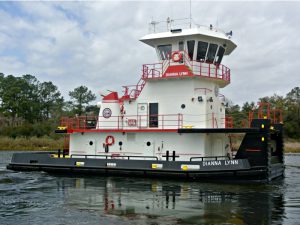
MARCH 26, 2016—Over the years, Rodriguez Shipbuilding, Inc.’s triple-screw towboats have won a following operating in the shallow waters where the Mississippi River meets the Gulf of Mexico. These Lugger-type vessels are
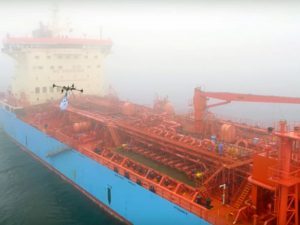
MARCH 11, 2016—The Maersk Group envisions that one day it will be able to use drones for vessel inspections, firefighting, surveillance for navigation and anti-piracy operations, and to deliver vital goods to
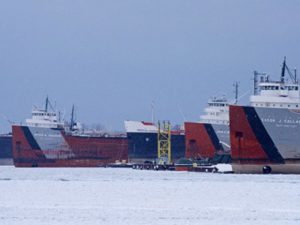
FEBRUARY 22, 2016 — Fincantieri Marine Group reports that 14 Great Lakes vessels are currently undergoing winter repairs at its Fincantieri Bay Shipbuilding division in Sturgeon Bay, WI. The vessels range in
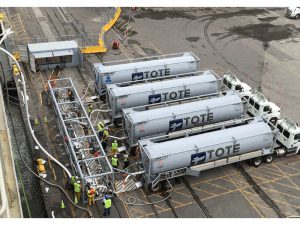
Last year, General Dynamics NASSCO earned the bragging rights for building and delivering the world’s first LNG-fueled containership, the Isla Bella, to Jones Act operator TOTE Maritime. The San Diego shipbuilder capped off that technological achievement last month by delivering the 764 ft Perla del Caribe, sister ship to the Isla Bella, two months early.
The two ships were built under a contract signed by TOTE in December 2012. The investment by TOTE in the two ships was $375 million.
TOTE President and CEO Anthony Chiarello, says that the “Isla Bella is already serving the people and communities of Puerto Rico and we are excited to introduce the Perla Del Caribe into the trade next month.”
GD NASSCO designed the ships in partnership with DSEC, a subsidiary of Daewoo Shipbuilding & Marine Engineering (DSME), located in Busan, South Korea.
The design is based on proven containership-design standards and includes DSME’s patented LNG fuel-gas system and a MAN ME-GI dual fuel, slow-speed engine. The 8L70ME-GI engine was built by Korea’s Doosan Engine under license from MAN Diesel & Turbo.
Burning LNG will allow the Marlin Class ships to be fully compliant with strict emissions regulations while operating in both the North American Emissions Control Area and the U.S. Caribbean ECA.
The Isla Bella made its first trip from Jacksonville, FL, to San Juan, Puerto Rico, November 24.
 On January 9, TOTE Maritime Puerto Rico successfully loaded LNG bunkers aboard the world’s first LNG powered containership, MV Isla Bella. Approximately 100,000 LNG gallons transported by 12 TOTE-owned LNG ISO containers were loaded on schedule. The bunkering was conducted under strict U.S. Coast Guard oversight while Isla Bella was also undergoing cargo operations.
On January 9, TOTE Maritime Puerto Rico successfully loaded LNG bunkers aboard the world’s first LNG powered containership, MV Isla Bella. Approximately 100,000 LNG gallons transported by 12 TOTE-owned LNG ISO containers were loaded on schedule. The bunkering was conducted under strict U.S. Coast Guard oversight while Isla Bella was also undergoing cargo operations.
The LNG was transferred from the ISO tank containers using a specially developed transfer skid developed by TOTE’s partner Applied Cryogenics Technologies (ACT) of Houston, TX. The transfer skid is designed to allow four ISO tanks to be transferred to Isla Bella at once, dramatically reducing transfer time.
The LNG was sourced by TOTE’s partner, JAX LNG, LLC, from AGL Resources’ LNG production facility in Macon, GA. Genox Transportation, a specialized LNG trucking partner of TOTE, transported the fuel to Jacksonville. Pivotal LNG, a subsidiary of AGL Resources, also provided transfer expertise to TOTE Maritime with its highly trained LNG experts, ensured the operation was conducted safely and in accordance with best industry practices.
Oversight of the operation both at shipside and on shore was provided by TOTE Services, Inc. (TSI), TOTE Maritime’s sister company that manages the vessels.
“We are very pleased with the results of this initial LNG bunker event and know that the use of LNG in our Marlin Class vessels will provide unprecedented environmental benefits both here in Jacksonville and in Puerto Rico,” says Tim Nolan, President of TOTE Maritime Puerto Rico. “We are indebted to USCG Sector Jacksonville for their diligent oversight and assistance that was invaluable and helped make this event a success. Our partners ACT, Pivotal LNG and Genox were also major components of our success. Our sister company, TSI, has developed significant expertise in LNG as a Maritime fuel and ensures that our vessels operate safely and efficiently using this environmentally superior fuel.”
Applied CryoTechnologies, Inc. (ACT) is the premier equipment supplier for cryogenics in North America. ACT is proud to be the first to market with this type of bunkering equipment for the marine industry. Leveraging ACT’s innovative style and unrivaled experience in LNG equipment is sure to bring success to any LNG fueling project.
Pivotal LNG brings liquefied natural gas to companies and industries throughout the United States through reliable, flexible and cost-effective solutions.
TOTE Maritime provides safe, reliable transportation at the fastest speed possible for the Puerto Rican and related Caribbean trades.
Meanwhile, Crowley Puerto Rico Services, Inc., Jacksonville, has selected Eagle LNG Partners as LNG supplier for the company’s new LNG-powered, Commitment Class ships, which will be delivered in 2017 for use in the U.S. mainland to Puerto Rico trade. To support Crowley’s LNG needs, Eagle LNG will build an LNG plant offering a capacity of 200,000 gallons per day (87,000 gallons per day initially) in Jacksonville. The state-of-the-art facility is slated to be operational by early 2017. The decision to partner with Eagle LNG was made by Crowley in part because of the companies’ shared commitment to the environment.
“Crowley is proud to take a leadership position in the industry’s shift to cleaner-burning, natural gas fuel solutions,” said Crowley’s John Hourihan, senior vice president and general manager, Puerto Rico services. “The partnership with Eagle LNG is an important first step in developing sustainable supply infrastructure to ensure these highly technical, environmentally friendly vessels operate to their full capability.”
“The marine sector represents a significant opportunity for LNG fueling in the U.S., and Eagle LNG is well-positioned to build the necessary infrastructure and provide the specialized logistics to facilitate this energy transformation,” said Dick Brown, CEO, Eagle LNG. “It takes companies like Crowley to lead that wave of change. Eagle LNG is proud to work with such a pioneering organization.”
“This project is an important investment in our community from both economic and environmental perspectives,” said Jacksonville Mayor Lenny Curry. “It clearly demonstrates the leadership role our region is playing in LNG development and progression, while strengthening our commitment to leaving a smaller footprint through cleaner-burning fuel.”
The supply agreement between Eagle LNG and Crowley will provide LNG fuel for the El Conqui and Taino, which are expected to be in service in the second quarter and fourth quarter of 2017 respectively. The Jones Act ships will replace Crowley’s towed triple-deck barge fleet, which has served the trade continuously and with distinction since the early 1970s. These new ships, will offer customers fast ocean transit times, while accommodating the company’s diverse equipment selection and cargo handling flexibility – benefits customers have enjoyed for nearly 60 years. The LNG plant is separate from the previously announced Eagle LNG Federal Energy Regulatory Commission (FERC) export terminal located along the St. Johns River, in Jacksonville, which will continue to focus on export markets in the Caribbean and Atlantic Basin.
DUAL FUEL BULKERS BUILT TO NEW DNV GL CLASS
ESL Shipping’s new dual-fuelled bulk carriers will not only be the first large LNG-fuelled bulkers, but the first vessels constructed to the new DNV GL rule set. Due for delivery in early 2018, the two highly efficient 25,600 dwt vessels are optimized for trading in the Baltic Sea region.
“It is fitting that the first vessels that will be constructed to the most forward looking set of classification rules are themselves at the cutting edge of maritime innovation,” says Knut Ørbeck-Nilssen, CEO of DNV GL – Maritime. “We have created these rules to be ready for the future and we have long pioneered the use of LNG as a ship fuel. To see these two come together in a double first for the industry is a remarkable moment. We look forward to working with ESL, Deltamarin, Sinotrans & CSC Qingshan Shipyard and all the project partners to make this project a success.”
“We are proud to be the world’s first shipyard applying the new and innovative DNV GL rules for a newbuilding, just two months after DNV GL has launched its new rules in October this year,” said Liu Guangyao, Deputy General Manager of Sinotrans & CSC at the Marintec China Trade Fair recently. “We appreciate the support that DNV GL has committed to provide on the project during both the design and construction phase, especially in a project with many advanced extra class notations. We are looking forward to a close cooperation and a successful delivery.”
Featuring the Deltamarin B.Delta26LNG design, the two highly efficient ships will feature dual-fuel main and auxiliary machinery, resulting in CO2 emissions per ton of cargo transported half that of present vessels. The bulk carriers will be built to the new DNV GL rules for general dry cargo ships with DNV GL ice class 1A and will have type C LNG tanks of approximately 400 m3 capacity enabling bunkering at several terminals within the Baltic region. The B.Delta26LNG has a shallow draft of maximum 10 m, an overall length of 160 m, and a breadth of 26 m.
“We are very excited to have been selected to take part in this ground breaking project,” says Morten Løvstad, Business Director Bulk Carriers at DNV GL. “Being asked to work with such an innovative team as the classification partner is a testament to the creativity and hard work that so many colleagues at DNV GL have invested in the new rule set. These vessels will set new standards for efficiency and environmental performance. They are an important step forward in showing how shipping can be a force for sustainability today and in the future.”
FIRST PURE LNG FERRY FOR GERMANY
Germany’s first LNG-fueled ferry, the MS Ostfriesland, has now been operating for AG Ems between Emden and Borkum Island on the ecologically sensitive Wadden Sea, since June 2015.
Originally built in 1985, the vessel was converted to dual fuel propulsion in a conversion that saw it fitted with a complete new aft end, construction of which got underway at German shipyard Brenn – und Verformungstechnik Bremen GmbH while the ship remained in service.
The new aft section, which extended the vessel’s length from 78.7 m to 93 m, houses the new machinery space and LNG fuel system/tank with the vessel now being propelled by two electrically powered Schottel STP Twin thrusters, each rated at 1,150 kW at 1,480 rpm.
While the prime movers are two 6-cylinder Wärtsilä 20DF dual-fuel generating sets, for navigating within harbors, the vessel uses two Mitsubishi auxiliary generators.
Switching to LNG fuel means providing against various unlikely malfunctions, such as an ignition failure resulting in an unburned mixture of gas and air in the exhaust. This could cause uncontrolled combustion and an increase in pressure the next time ignition takes place, putting a substantial strain on the pipe components.
To protect against this, the Mitsubishi auxiliary generators are protected by a Q-Rohr flameless venting system by German manufacturer Rembe GmbH that ensures that the reaction is vented directly at the exhaust.
Both the flame and the pressure are absorbed by the stainless steel mesh filter of the Q-Rohr, providing optimum protection for the pipe components and the environment.
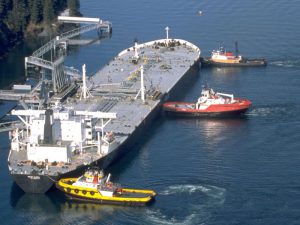
FEBRUARY 4, 2016 – Crowley Maritime Corporation’s tanker escort and docking services group in Valdez, AK, is celebrating over seven million man hours and more than six years since logging its last
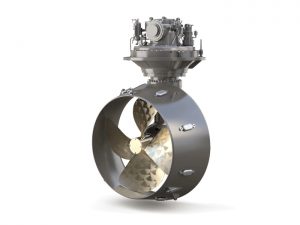
The International Workboat Show in New Orleans, LA, offers the marine industry an ideal time to not only assess the current state of the industry, but also an opportunity to view some of the newest technologies, products, and services. With stricter emissions regulations coming into play in 2016 and operators strongly focused on efficiency and the bottom line, this year’s show saw a number of new power and propulsion technologies unveiled. GE Marine, for example, extended its EPA Tier 4 engine series to include 16- and 12-cylinder V-models, an 8-cylinder inline model, and a 6-cylinder inline model that is currently planned for development.
GE says the engine series meets the Environmental Protection Agency’s (EPA) Tier 4 emission standards without the use of urea after-treatment, while maintaining fuel efficiency and service intervals. In addition, the engines have a faster response time to load steps, and a Maximum Continuous Rating (MCR) that is 12 percent higher than their Tier 3 compliant predecessors.
Coastal tug and barge operator Reinauer Transportation purchased two 12V250MDC Tier 4 diesel engines for its new Articulated Tug Barge (ATB) unit under construction at Senesco Marine in Kingstown, RI. One of the engines was displayed at GE’s booth at the Workboat Show.
“We chose the new GE Marine engines because we like their robust design and component configuration,” says Christian Reinauer. “The engine closely matches the footprint of our current vessel design. This limits the amount of re-engineering while meeting Tier 4 emissions requirements without the complications of urea after-treatment.”
GE’s Marine Product Manager Rob Van Solingen says the engines offer several advantages as compared with engines that use an SCR-based emission control system.
He says that the GE Tier 4 engines are less complex, allowing ship designers to develop engine rooms that make the most efficient use of space. This reduction in complexity also translates into improved labor efficiency at shipyards.
The engines also offer space and weight savings, since there is no large SCR reactor system in the exhaust piping of each engine nor any urea tank, dosing equipment, monitoring/control systems, and related piping, and air supply system required.
“Depending on size and urea quantities, space and weight savings of the engine and complete SCR system with all components and urea tanks can save up to 75% on each when compared to the GE T4 diesel engine,” says Van Solingen.
In addition, says Van Solingen, “The EGR system is designed to not require any special maintenance between the normal scheduled overhaul intervals for our engines.”
Other U.S.-based customers Harvey Gulf International Marine and Oceaneering have also ordered 12V250MDC Tier 4 engines to meet stricter EPA emissions standards. Two 12V250MDC Tier 4 diesel engines will power Harvey Gulf’s new Robert Allen designed Multi-Purpose Field Support Vessel, currently under construction at Eastern Shipbuilding Group in Panama City, FL.
Meanwhile, Oceaneering has ordered five 12V250MDC Tier 4 diesel engines for its new Inspection, Maintenance and Repair (IMR) vessel MSV Ocean Evolution under construction at BAE Systems in Mobile, AL.
NEW ENGINE FROM MAN
Also on display at the WorkBoat Show was a new inline six-cylinder diesel engine range for workboats, ferries, fishing trawlers, and pilot boats based on the MAN D2672 diesel engine from MAN Engines. Offered in a range of outputs from 323 kW to 588 kW (440 to 800 hp), the basic six-cylinder engine has been proven in a wide range of on- and off-road machinery since it was first introduced in 2007. Its robustness and reliability in workboats has also been demonstrated in extensive field trials over several thousand hours of use in ferries, pilot boats and high-speed catamarans.
The modern common rail injection system used in the D2676, with fuel pressures up to 1,800 bar, ensures high mean pressures and optimized combustion. This increases on-board comfort due to reduced vibration and noise emissions. The inclusion of a Miller or Atkinson camshaft has helped to achieve an average 10% reduction in fuel consumption compared to the engine’s predecessors.
As part of this improvement in fuel consumption, all engines also comply with the current strict EPA emissions.
The new MAN D2676 marine diesel engines replace the predecessor models D2866 and D2876.
The new D2676 engines also offer the wide torque plateau that is characteristic for MAN marine engines. The 323 kW (440 hp) power unit provides 1,950 Nm of torque between 1,200 and 1,600 rpm for heavy operations, while the 588 kW (800 hp) high-performance model manages to generate 2,700 Nm between 1,200 and 2,100 rpm for light operations. This ensures maximum torque over a broad engine speed range at the lowest specific fuel consumption.
SCANIA MAKES IN ROADS
Scania has been making inroads in the marine propulsion sector because of its compact, proven engine platforms. Some recent installations in the U.S. Gulf of Mexico include the high-speed crewboat Fourchon Runner, which is powered by quadruple Scania 16L engines for a total of 2,400 hp.
Naiad Inflatables recently delivered the Karankawa, a twin-screw pilot vessel for the Matagorda Bay Pilots of Texas. The pilot boat has two Scania DI13 77M main engines, with Twin Disc MGX-5114A gears and ZF controls. It employs shaft propulsion with driveline components from H&H and Michigan Wheel propellers. The pilot boat has a top speed is 33 knots.
At the Workboat Show, Scania showcased its Tier 3 platform, including its 16-liter V8 and 13 liter inline engines.
Scania engines are all based on Scania’s new modular engine platform—well proven in the company’s truck and bus engines. Scania V8 engines are engineered to produce high power, while maintaining a size that is compatible for auxiliary equipment. The V design reduces the overall length of the engine and ancillaries can be effectively accommodated inside the footprint of the engine.
The output ratings for Scania’s newest Tier 3 version of the 16-liter marine propulsion engine range from 550 to 900 hp, with outputs between 550 to 1,000 hp available for use in international and exempt markets.
For auxiliary applications, the range for EPA Tier 3 is 468 kW – 553 kW, and the current range will continue to be offered between 430 kW – 596 kW for international and exempt markets. Scania also expects to see an increase in the output ratings of V8 engines used for keel-cooled applications.
The output ratings for Scania’s newest Tier 3 version of the 13-liter inline marine propulsion engine range from 250 – 675 hp, with outputs up to 750 hp available for use in international and exempt markets. For auxiliary applications the range for EPA Tier 3 is 269 kW – 426 kW.
Scania’s centrifugal oil cleaner effectively removes small particles from the lubrication oil, while reducing the size of the replaceable filter cartridge. The Scania saver ring, placed at the top of each cylinder liner, reduces carbon deposits on the edge of the piston crown and reduces cylinder liner wear.
In spite of higher performance and tighter emission levels, Scania has been able to increase maintenance and oil change intervals by 25% (now 500 hours) in comparison to its predecessor.
NEW CONCEPT: TWIN FINS
During a presentation for the trade press at the Workboat Show, Caterpillar highlighted the development of its Twin Fin Propulsion Systems. The initial Twin Fin Propulsion System was retrofitted on the seismic vessel Polarcus Naila at Shipdock in Amsterdam in March 2014.
“In the seismic business, seismic assets or the vessel is a huge workhorse,” says Peter Zickerman, Polarcus Executive Vice President. “About 85 percent of its lifetime, the vessel is under constant tow in various weather conditions. It is imperative that the reliability of the vessel and its propulsion system are top notch.”
The Twin Fin is designed for vessels that operate on a diesel-electric propulsion system. With thrusters, vessels can have more cargo capacity. With conventional propellers, operators benefit from added reliability and safety. Twin Fin offers the advantages of both. It offers higher thrust performance, reduced fuel consumption, and a better emissions profile.
According to Mattias Hansson, naval architect and sales manager at Caterpillar Propulsion, development of the Twin Fin Propulsion Systems started with the company’s partners in the third quarter of 2012 and a patent application was filed in the first half of 2013. Hansson points out that the Twin Fin Propulsion System also incorporates some green aspects, including, a water-lubricated stern tube, instead of an oil-lubricated system.
For the retrofit, the twin fins were prefabricated in about 15 days and readied for the Polarcus when she arrived at the shipyard.
“This new system provides an excellent course keeping stability for the ship—important for a scientific ship like this,” says Henning Kuhlmann, Managing Director, Becker Marine Systems. Becker Marine Systems supplied highly efficient flat rudders for the installation of the Twin Fins.
The payback period for the system is about three years based on fuel consumption savings, efficiency gains, improves environmental footprint, and improves reliability when operating in remote areas.
In the coastal market, Caterpillar is supplying two harbor tugs being built for Harley Marine Services, Seattle, WA, at Diversified Marine, Inc., Portland, OR.
Each of the Harley Marine tugs will be outfitted with Cat 3516 main engines—each rated at 2,575 hp at 1,600 rev/min—and two MTA 524-T azimuthing thrusters. The thrusters will have 95.5 in. diameter fixed-pitch propellers.
Cat Propulsion’s Emil Cerdier says the MTA-T thrusters deliver “excellence of economy and performance to the tug market.” The tugs will be delivered by Diversified Marine in 2017.
Z-DRIVES GO INLAND
While Z-drives are fairly commonplace in the tug market, they are a relatively new phenomena in the inland towboat market. While some were installed as early as the 1980s, Z-drives got a major boost in 2006, when Bill Stegbauer and Ed Shearer began exploring the use of alternative propulsion, including Z-drives in inland towboats. Stegbauer, then President of Southern Towing Co., eventually opted for a design that would use Z–drives in a series of 3,200 hp towboats.
There are now about two dozen towboats operating with Z-drives and more are under construction. One of the latest series of three 6,300 hp towboats designed by The Shearer Group that are being built at C&C Marine and Repair, Belle Chasse, LA, for SCF Marine Inc. As you might guess, Ed Shearer is the President of The Shearer Group.
The towboats will each have three Cummins QSK60-M diesel engines coupled to three Steerprop SP-25D z-drives. Cummins Mid-South is supplying the engines, while Karl Senner, LLC, Kenner, LA, is supplying the Z-drives.
The Z-drives were selected only after a through analysis. “We worked closely with the both the owner and the naval architect, but at the end of the day, the decision was up to the owner, SCF,” says Karl Senner. “Tim Power and Myron McDonough were very diligent in the selection process, and we very much appreciate the in-depth approach and attention to detail. We pride ourselves in offering robust products and superior support, factors that are critical while operating in the demanding environment of the inland waterways. Steerprop units are designed for the longest time between overhauls on the market. We have also been supporting inland operators since our company’s inception in 1967. We are very excited about our relationship with SCF and we know it will continue for a long time to come.”
Steerprop SP25D Z-drives are designed for operating in harsh environments. These specific drive units were selected and configured similar to that of ice-class applications. Ice class design is Steerprop’s forte, having designed and supplied Z-drives on board three of the world’s largest mechanical Z-drive ice breakers build to date.
These will be the first inland towboats in the U.S equipped with Steerprop Z-drives. “The inland waterways have been a major focus of our business since 1967 for Reintjes gearboxes,” says Senner. “We pride ourselves in knowing what it takes to support the high demands of our inland customers, from sizing the appropriate equipment, to stocking spare parts, and providing quick service turnarounds. We are a family-owned and -operated company, flexible to respond to customer needs quickly and effectively.”
“We are in discussions with multiple other inland projects, but not at liberty to discuss them at this point in time.”
Z-drives have begun to catch on with inland transportation operators because of the safety, operational efficiencies and fuel savings they offer. As operators of harbor tugs have long been aware, the Z-drive can deliver full thrust in any direction almost instantly, where as the conventional rudder set aft of the propeller and even the flanking rudders set ahead of the rudder as is the practice on many inland river towboats, will sacrifice time and power by the inefficient nature of the conventional drive and rudder system.
Due to the greatly improved maneuverability with Z-drives, tows do not need to slow down in turns and bends in the river. Trip times are reduced and require a lot less fuel. A study conducted by The Shearer Group, Inc. last year showed an average of 28% fuel savings and 11% trip time savings during a set of controlled experiments with unit tows when using Z-Drives instead of conventional shafts and rudders.
SCF Marine, Inc., St. Louis, MO, is part of SEACOR’s Inland River Services group. SCF Marine operates a fleet of hopper barges along the U.S. Inland River Waterways and South America, transporting agricultural, industrial, and project cargoes.
Thrustmaster of Texas, Inc., Houston, TX, says towboats with Z-drives are not significantly more expensive than conventional towboats. The initial cost of the Z-Drives is significantly offset by reduced construction costs and installation man-hours. Shipyards have reported that the cost of building Z-drive boats is actually less than building conventional boats.
One of the latest applications of Z-drive propulsion is in a fleeting boat by Carline Companies. Carline recently added the 68 by 34-foot towboat USS Cairo for barge fleeting on the lower Mississippi.
Designed by Christian Townsend of CT Marine and built by Raymond & Associates, the USS Cairo is fitted with two six-cylinder Tier 3 compliant Cummins QSK19 main engines turning Thrustmaster TH750MZ Z-drives with 57-inch propellers.
According to Thrustmaster of Texas, a Z-drive replaces the propeller, shaft, stern tube, marine gear, rudder and steering gear all with a single unit. Z-drive azimuthing thrusters provide maximum thrust in any direction, independent of vessel speed, offering superior pinpoint maneuverability under all conditions. Rudders are completely eliminated. Rudder drag no longer exists. All of this can be done with a lot less power. A 1,500 hp Z-drive boat can replace a 2,000 hp conventional towboat and a 3,000 hp Z-drive boat can replace a 4,000 hp conventional towboat.
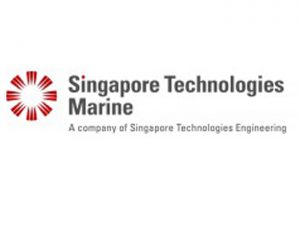
JANUARY 4, 2016 — Singapore Technologies Engineering Ltd reports that its marine arm, Singapore Technologies Marine Ltd (ST Marine) has secured new orders worth about S$344 million for its Shiprepair and Engineering
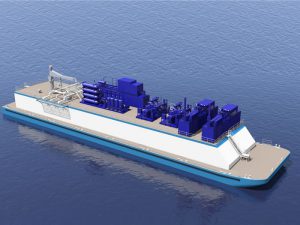
The team, led by Siemens Drilling and Marine, Dresser-Rand and Lloyd’s Register, aims to provide an end-to-end solution, encompassing the entire supply chain, that will remove obstacles that can hold back wide-spread adoption of natural gas as the marine fuel of choice.
“Our integrated solution, encompassing the entire supply chain of LNG including gas-fueled marine propulsion systems, will remove the chicken-and-egg hurdle from the LNG-equation,” says David Grucza, Siemens Drilling and Marine. “This is a disruptive concept for the maritime industry, and the technology exists for immediate adoption. This joint solution is not limited geographically, and we stand ready to support the marine industry globally, although our initial focus is on deploying U.S. shale gas.”
The initial end-to-end solution offered to the North American inland and coastal waterways community comprises the following elements
It has been designed and engineered by Waller Marine Inc. (WMI) and the Shearer Group Inc. (TSGI), respectively, and will be constructed by Conrad Industries shipyard in Texas.
“Together, the team brings a holistic answer to the LNG marine fuel question of what comes first – the bunkering station or the engine?” says David Waller, President, Waller Marine, Inc. “The innovative solution to this industry hurdle includes the entire supply chain from liquefaction, LNG bunkering and design, all while meeting EPA and USCG compliance and providing smart, sustainable, lower greenhouse gas alternative fuels to operators.”
“Lloyd’s Register is well placed to support a new fleet of gas-fueled ships – and help them to operate safely and efficiently,” says Mark Darley, Americas Regional Marine Manager and President of Lloyd’s Register North America (LRNA). “Our expertise and leadership in gas technology and operations – from gas carriers to LNG bunkering and gas as a marine fuel – helps lead to the best decisions based on the best, independent, technical insight.”
Lloyd’s Register has established clear standards describing different levels of readiness to use natural gas as a marine fuel. Lloyd’s Register also provides training on the key practical aspects of modern LNG carriage by sea and risk management services to support safe LNG bunkering.
Siemens AG (Berlin and Munich) is active in more than 200 countries, focusing on the areas of electrification, automation and digitalization. One of the world’s largest producers of energy-efficient, resource-saving technologies, Siemens is No. 1 in offshore wind turbine construction, a leading supplier of gas and steam turbines for power generation, a major provider of power transmission solutions and a pioneer in infrastructure solutions.
Dresser-Rand, a Siemens Business, is among the largest suppliers of rotating equipment solutions to the worldwide oil, gas, petrochemical, and process industries.
Lloyd’s Register (LR) is the leading classification society in the gas carrier market – both for LNG and LPG – and is also taking a leadership role in the international development of gas as a marine fuel.
Waller Marine, Inc. is a global leader in the design of Floating Gas to Liquids (GTL), Floating Power Generation and Floating Liquefaction (LNG) and is is a licensed engineering firm with EPC capabilities.
Conrad Industries Inc. specializes in the construction, conversion and repair of a wide variety of marine vessels for commercial and governmental customers and the fabrication of modular components of offshore drilling rigs and floating, production, storage and offloading vessels.It has been awarded a contract to build a 2,200 cu.m. LNG bunkering barge — the first in the U.S.
The Shearer Group, Inc., founded in 2010, provides naval architecture, marine engineering, marine surveying and professional engineer services to clients in the inland and offshore marine industries.
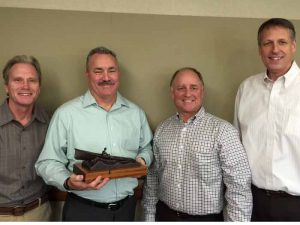
Crowley’s Chairman, President and CEO Tom Crowley Jr., the grandson of the company’s founder, presented the award before more than 70 employees and senior leaders including two past recipients of the award, Bruce Harland, vice president, marine solutions, and Craig Tornga, vice president, government relations.
Mr. Ridge, a 30-year Crowley employee, was selected for the award because of his reputation for high performance. In his nominating letter, Crowley’s Captain Rod Jones, general manager, marine services, wrote: “David has proven his competence, loyalty and exemplary performance time and again, both aboard the vessels and in the office. Whether commanding Crowley assets half-way around the world or facilitating a training seminar in Valdez, his commitment to the core principles of safety, integrity and high performance have never waned. He projects an aura to those around him that not only instills confidence in his ability, but also trust in his judgement – a tireless and effective manager, who demonstrates daily the leadership skills he has honed over years of decision making in stressful situations.”
Mr. Ridge joined Crowley in 1984 as a mate, subsequently working aboard a variety of vessels operated by the company, including oil and cargo barges, offshore towing tugs, and ship assist and tanker escort tugs. In 1986, he was assigned master for Crowley’s military support service operating out of Sasebo, Japan, before transferring aboard Crowley’s harbor ship assist and tanker escort tugboat fleet in San Francisco Bay in 1987. He continued working aboard company tugs until 1996, when he changed roles again, as master of tow operations of Crowley’s 450 series barges transiting U.S. West Coast oil terminals. He came ashore as port captain in Seattle in 2005, and was later assigned to manager, marine operations, in Valdez, Alaska, for the ship assist and tanker escort contract with Alyeska SERVS in 2007. In 2014, he was promoted to his current position of director, marine operations, in Valdez.
“It’s not often that we see a tug captain come ashore,” said Mr. Crowley, on presenting the award. “It’s a difficult transition … I can’t think of a more difficult place to work [than Valdez.] Dave has taken a true leadership role there … in making sure the customer has confidence, that we are there to get the job done and to work with a great team. I congratulate him on his efforts.”
“I am honored to have received this award, but the recognition really should go to my team,” said Mr. Ridge. “Crowley is the most unique and worthwhile company I have ever had the pleasure of working for and it’s the people I work with who make me who I am. I share this award with them.”
The Thomas Crowley Award was created in 1985 and only 60 of the company’s more than 5,300 employees have received the award which symbolized by a limited edition bronze sculpture, which depicts company founder Thomas Crowley ferrying goods to and from ships on San Francisco Bay in the early 1890s.